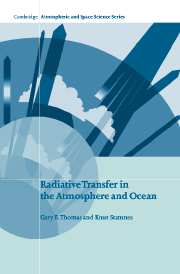Book contents
- Frontmatter
- Contents
- List of Illustrations
- Preface
- Acknowledgments
- Chapter 1 Basic Properties of Radiation, Atmospheres, and Oceans
- Chapter 2 Basic State Variables and the Radiative Transfer Equation
- Chapter 3 Basic Scattering Processes
- Chapter 4 Absorption by Solid, Aqueous, and Gaseous Media
- Chapter 5 Principles of Radiative Transfer
- Chapter 6 Formulation of Radiative Transfer Problems
- Chapter 7 Approximate Solutions of Prototype Problems
- Chapter 8 Accurate Numerical Solutions of Prototype Problems
- Chapter 9 Shortwave Radiative Transfer
- Chapter 10 Transmission in Spectrally Complex Media
- Chapter 11 Radiative Transfer in Nongray Media
- Chapter 12 The Role of Radiation in Climate
- Appendices
- Index
Chapter 4 - Absorption by Solid, Aqueous, and Gaseous Media
Published online by Cambridge University Press: 18 December 2009
- Frontmatter
- Contents
- List of Illustrations
- Preface
- Acknowledgments
- Chapter 1 Basic Properties of Radiation, Atmospheres, and Oceans
- Chapter 2 Basic State Variables and the Radiative Transfer Equation
- Chapter 3 Basic Scattering Processes
- Chapter 4 Absorption by Solid, Aqueous, and Gaseous Media
- Chapter 5 Principles of Radiative Transfer
- Chapter 6 Formulation of Radiative Transfer Problems
- Chapter 7 Approximate Solutions of Prototype Problems
- Chapter 8 Accurate Numerical Solutions of Prototype Problems
- Chapter 9 Shortwave Radiative Transfer
- Chapter 10 Transmission in Spectrally Complex Media
- Chapter 11 Radiative Transfer in Nongray Media
- Chapter 12 The Role of Radiation in Climate
- Appendices
- Index
Summary
Introduction
Most particles in the atmosphere and the ocean (except those responsible for the density irregularities leading to Rayleigh scattering) are also absorbers of radiation. Absorption causes the incident radiation to be further weakened (in addition to scattering) by losses within the particles themselves. As explained in Chapter 3 the net effect of scattering and absorption is called attenuation or extinction. Absorption is inherently a quantum process resulting from the fact that matter contains energy levels that can be excited by the absorption of radiation. A transition from an initial quantum state to a higher-energy state is highly dependent on the frequency or energy of the incident light. When the photon energy is close to the energy difference between the initial and final state, the atoms and light may be said to be in resonance, and the absorption is comparatively high. Conversely, when the photon energy is not close to the transition energy, the absorption is often much weaker than the scattering and is not easily measurable. This energy selectivity is the outstanding characteristic of absorption. (In contrast, scattering is generally much less selective and usually has a smoothly varying efficiency with wavelength.) Selective absorption causes individual molecular absorption spectra to be very complex. The resonances are usually very sharp, and because of the many modes of excitation of molecules (particularly the polyatomic molecules of greatest interest to us) there may exist tens to hundreds of thousands of discrete absorption lines in molecular spectra.
- Type
- Chapter
- Information
- Radiative Transfer in the Atmosphere and Ocean , pp. 84 - 129Publisher: Cambridge University PressPrint publication year: 1999



